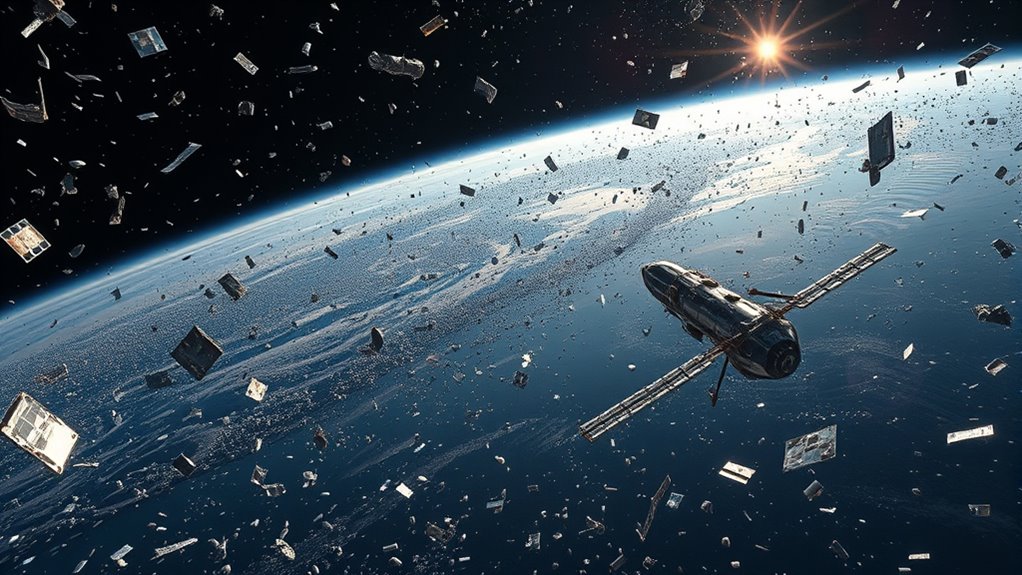The space junk crisis in 2025 threatens your satellite operations and space missions. To tackle this, efforts focus on designing longer-lasting, repairable satellites that safely de-orbit at end of life, and deploying advanced debris removal tech like robotic arms and laser systems. International cooperation and stricter launch policies also help reduce new debris. Staying informed about these strategies is vital, as continued advancements will shape the future of safe and sustainable space activities.
Key Takeaways
- Advancements in debris removal technologies like robotic arms, nets, and laser ablation aim to actively clear orbital debris by 2025.
- Enhanced satellite designs focus on sustainability, repairability, and safe end-of-life deorbiting to reduce future space junk.
- International cooperation and stricter policies are being implemented to promote debris mitigation and responsible satellite launches.
- Private sector investments are accelerating the development and deployment of cost-effective debris removal solutions.
- Integrating debris management strategies into space operations is crucial to prevent exponential growth of orbital debris by 2025.

The growing accumulation of debris in Earth’s orbit has created a serious space junk crisis that threatens both current and future space activities. With thousands of pieces of defunct satellites, spent rocket stages, and fragments from collisions orbiting at high speeds, every mission you undertake faces increased risks. This clutter not only jeopardizes satellite operations but also endangers crewed spacecraft and the International Space Station. To address this, the focus has shifted toward enhancing satellite sustainability and developing effective debris removal technology. These efforts are essential in preventing the cascade effect, where collisions generate even more debris, compounding the problem exponentially.
Space debris accumulation endangers missions, satellites, and the ISS—urgent need for sustainable design and debris removal tech.
Satellite sustainability involves designing spacecraft that can operate longer, be easily repaired, or de-orbited safely at the end of their operational life. You’re encouraged to consider modular designs that allow for upgrades, reducing the need for launching new satellites and decreasing debris creation. Implementing active end-of-life disposal mechanisms ensures satellites don’t become space junk once they expire. By prioritizing sustainability, you help minimize debris generation from the outset, making space operations more manageable and reducing the burden on debris removal technology.
When it comes to debris removal technology, innovative methods are emerging to clear the orbital environment. You might see the deployment of robotic arms, net capture systems, or laser ablation techniques that target small fragments without creating additional debris. These technologies aim to actively deorbit debris or safely move it to a graveyard orbit, reducing collision risks. Countries and private companies are investing heavily in these solutions, recognizing that passive measures alone won’t suffice. The success of debris removal technology hinges on its ability to operate reliably in the harsh conditions of space while being cost-effective enough for widespread deployment.
In the broader context, your role as a stakeholder in space activities involves supporting policies and initiatives that promote sustainable satellite design and advanced debris removal systems. The integration of these technologies can substantially mitigate the space junk crisis, prolonging the viability of orbital operations. As new satellites are launched, adherence to debris mitigation guidelines ensures minimal contribution to the problem. You’re also encouraged to advocate for international cooperation, since space debris is a global issue requiring shared responsibility and coordinated action.
Ultimately, tackling the space junk crisis by advancing satellite sustainability and deploying debris removal technology is vital to safeguard the future of space exploration, communication, and research. Your efforts today can help preserve the orbital environment, ensuring it remains a resource rather than a hazard for generations to come.
Frequently Asked Questions
What New Technologies Are Being Developed to Remove Space Debris?
You’re exploring new tech like robotic cleanup systems and laser removal methods to tackle space debris. Robotic cleanup uses autonomous drones or ships to capture or de-orbit debris efficiently. Laser removal involves ground-based or space-based lasers that can weaken debris’ orbit, making it burn up in the atmosphere. These innovations aim to reduce collision risks and preserve space for future missions, ensuring a safer orbital environment for everyone.
How Will International Cooperation Improve Orbital Debris Management?
Did you know there are over 23,000 pieces of debris larger than 10 cm orbiting Earth? International cooperation will considerably improve debris management through international treaties and collaborative efforts. These agreements promote shared responsibility, data sharing, and joint cleanup initiatives, making space safer for everyone. When countries work together, they can develop standardized protocols, pool resources, and accelerate debris removal, ensuring sustainable use of Earth’s orbits for future generations.
What Are the Economic Impacts of Space Junk on Satellite Industries?
You’ll face economic disruption as space junk increases, making satellite operations riskier and more expensive. Higher collision chances can lead to costly satellite damage, raising satellite insurance premiums. This impacts your industry by increasing operational costs and potentially limiting satellite deployment. As debris threatens satellite reliability, your business must invest more in debris mitigation and insurance, which could slow growth and innovation in the satellite industry.
Can Space Debris Cause Long-Term Environmental Damage on Earth?
Yes, space debris can cause long-term environmental damage on Earth. When debris re-enters the atmosphere, it can contribute to environmental pollution through toxic materials and metal fragments. Additionally, the accumulation of debris in orbit threatens wildlife disruption, as uncontrolled reentry or satellite crashes might release harmful substances or impact ecosystems. This ongoing pollution and wildlife risk highlight the importance of managing space debris to protect our environment.
How Do Private Companies Contribute to Debris Mitigation Efforts?
Imagine a team of vigilant artisans, shaping a cleaner sky. Private companies contribute to debris mitigation through private sector innovation, developing advanced debris cleanup technologies and strategies. They also fund efforts to safely remove or repurpose space junk, turning chaos into order. By investing in these initiatives, they help safeguard our orbital environment, ensuring sustainable space operations and inspiring confidence in our shared future among all who reach for the stars.
Conclusion
As you watch the skies, it’s no coincidence that efforts to clear space junk are gaining momentum just as satellite traffic surges. The timing feels right, almost inevitable, that we’re finally tackling this debris crisis. You realize that in a world of constant change and endless possibility, it’s the small steps—like removing debris—that make the biggest difference. Because when it comes to protecting our future in space, every piece counts.









